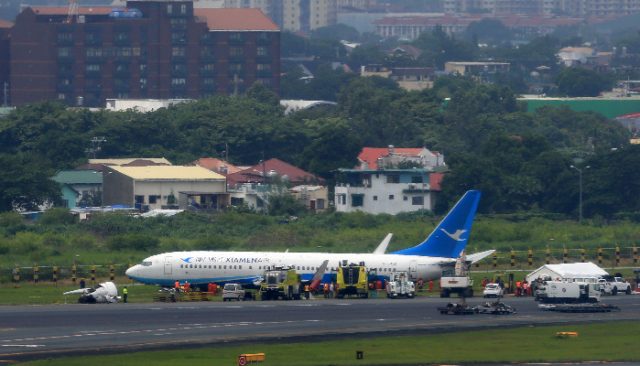
(Updated 3:34 p.m.) Several flights at the Ninoy Aquino International Airport have been cancelled following the crash landing of a Boeing 737-8000 owned by Xiamen Air last week. Citizens and officials have begun to search for answers and solutions as the tangle of stranded passengers remains thick.
Chaos at the airport
At least 69 flights were cancelled on Sunday, affecting around 13,000 passengers.
About 200 flights from different airlines had previously been cancelled on Friday, the day after the Xiamen Air aircraft with 165 passengers overshot the runway at the country’s main airport.
The Philippines’ airlines have revealed the staggering number of affected passengers. Philippine Airlines revealed that its 68 cancelled flights affected 18,810 passengers while its 21 diverted flights affected 5,483 more.

Budget airline Cebu Pacific meanwhile related that it was assisting around 20,000 affected passengers from its cancellations and diversions, not including those affected by delayed flights.
Several travelers have shared stories and images from the chaos at the airport in the days after the crash.
Heading over to NAIA terminal 1. Here's the view from our position. #MovePH pic.twitter.com/mbhSK0hvp5
— Justine Diza (@justinediza) August 18, 2018
The chaos in NAIA T2 last Saturday – I was in the terminal starting 6am, flight canceled at 11am, rebooked after 4hrs in line, got home at 6pm. @flyPAL@MIAAGovPH https://t.co/E8Q84277m0
— kin| Boardinggate101 (@Boardinggate101) August 20, 2018
The airport’s troubles have reached a number of government officials, including Sen. Grace Poe, who expressed her frustration and called for an immediate investigation into the chaos.
NAIA Terminal 1 Departures at around noon. Day 3 since airport paralysis and here we are. Frustrating. pic.twitter.com/1jX9mHlc2j
— GRACE POE (@SenGracePOE) August 19, 2018
Sen. JV Ejercito, who had just left Davao a few days after the Xiamen aircraft’s mishap, related how some workers at NAIA left the scene, leading to stalled movement at the airport.
What made things worse with airport chaos in NAIA is that Skylogistics Airport Services assigned to handle check in counters and boarding gates walked out saying its not their shift anymore leaving morning sked flights.
— JV Ejercito (@jvejercito) August 19, 2018
In another tweet, he suggested that a twin airport system may be the answer to NAIA’s congestion problem.
At this point the quickest solution for Manila’s airport problems is to have a twin airport system between Clark and NAIA, just like Haneda & Narita in Tokyo. Need to fast track PNR north rail line to Clark and the construction of the P12 Billion terminal building.
— JV Ejercito (@jvejercito) August 18, 2018
Poe, who chairs the Senate committee on public services, announced the she will be opening an inquiry into the operational procedures of airport personnel in responding to such emergency situations.
Xiamen Air did something else
Some have called for Xiamen Air to be penalized for sending four recovery flights to NAIA without proper coordination with Manila’s airport authorities following the recovery of its damaged Boeing 737.
I’m not familiar with CAAP rules, but can’t Xiamen Airlines’ landing rights be suspended for such disregard for protocols in the aftermath of the airport shutdown caused by their aircraft? https://t.co/MQqWp0zB6w
— Ruffy Biazon (@ruffybiazon) August 20, 2018
The recovery flights caused other airlines to delay or cancel their flights, as NAIA’s runway remained congested.
The sheer number of cancelled and delayed flights led to the volume of passengers stuck in the airport.
MIAA General Manager Ed Monreal however said that his agency did not have the authority to penalize airlines that snubbed airport protocol, reported ABS-CBN news.
Monreal also said that the MIAA will be joining the Civil Aviation Authority of the Philippines in investigating the matter.
What else went wrong?
Bad weather conditions and miscommunication between pilots and airline control personnel are the other factors being looked at that may have caused the trouble on the runway. Strong rainfall in Metro Manila was noted on the evening of the accident.
Monreal at a press conference on Monday afternoon said they discovered 61 recovery flights which were not properly coordinated with authorities, leading to further congestion on the runway.
As there is only a limited number of parking slots on the runway at any given time, several flights were delayed due to the pile-up.
He added that Xiamen Air has since apologized for the trouble and will work with Philippine air transport authorities on further investigation.









